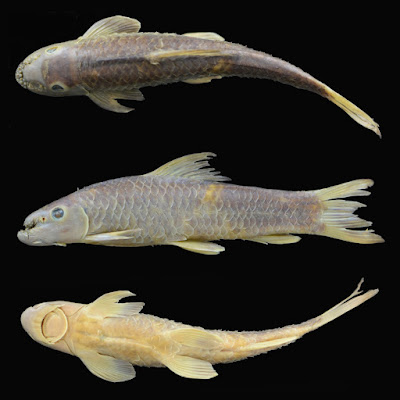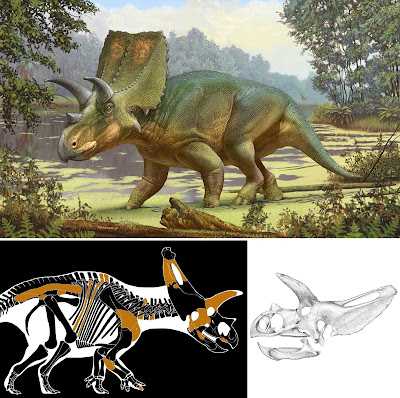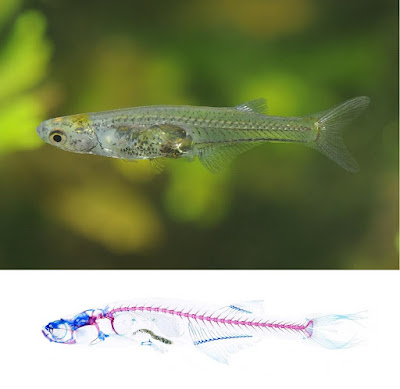[Most Recent Entries] [Calendar View]
Monday, October 4th, 2021
| Time | Event | ||||||
| 4:14a | [Ichthyology • 2021] Garra jaldhakaensis • A New Cyprinid Fish (Teleostei: Cyprinidae) from West Bengal, India
Abstract Garra jaldhakaensis sp. nov. (Teleostei: Cyprinidae) is described from the Jaldhaka River, Kalimpong district, West Bengal, India. The new species is distinguished from all its congeners in the Indian sub-continent in having a combination of the following characters: a prominent thick unilobed proboscis, protruding downward above the transverse groove; 10–11 predorsal scales, 33 lateral line scales and 16 circumpeduncular scales. Keywords: Brahmaputra Basin, Cyprinidae, India, New Species
Garra jaldhakaensis sp. nov. Diagnosis: Garra jaldhakaensis sp. nov., a member of the proboscis and transverse lobe species group, is distinguished from all congeners in the Ganga-Brahmaputra River drainage in having the following combination of characters: snout with a prominent tuberculated unilobed proboscis protruding downward above the transverse groove and transverse lobe covered with 16–25 medium-to large-sized multicuspid tubercles; 10–11 predorsal scales, 33 lateral line scales, 16 circumpeduncular scales, scaled chest and belly. Distribution: Garra jaldhakaensis sp. nov. is presently known only from the type locality Jaldhaka River near Jhalong, Kalimpong district, West Bengal, India. Etymology: The species is named after the type locality, Jaldhaka River, West Bengal, India. Laishram Kosygin, Bungdon Shangningam, Pratima Singh and Ujjal Das. 2021. Garra jaldhakaensis, A New Cyprinid Fish (Teleostei: Cyprinidae) from West Bengal, India. Records of the Zoological Survey of India: A Journal of Indian Zoology [Rec. zool. Surv. India]. 121(3); 325–331. DOI: 10.26515/rzsi/v121/i3/2021/158415 | ||||||
| 5:36a | [Paleontology • 2021] Sierraceratops turneri • A New Chasmosaurine Ceratopsid (Dinosauria: Ceratopsidae) from the Hall Lake Formation (Upper Cretaceous) of south-central New Mexico
Abstract The horned dinosaurs (Ceratopsidae) were a diverse family of herbivorous dinosaurs originating in the Late Cretaceous in western North America (Laramidia). As one of the most species-rich dinosaur groups, their diversity and distribution are important to understanding Cretaceous dinosaur evolution. Ceratopsids have previously been hypothesized to have high levels of endemism despite inhabiting a relatively small land mass with few barriers to dispersal. Here, we document a new chasmosaurine ceratopsid, Sierraceratops turneri gen. et sp. nov., from the Upper Cretaceous (latest Campanian–Maastrichtian) Hall Lake Formation of south-central New Mexico, consistent with the hypothesis that southern Laramidia supported an endemic dinosaur fauna. Sierraceratops is distinguished by its relatively short, robust, and mediolaterally compressed postorbital horns; a flattened medial ridge on the posterior end of the pterygoid; a jugal with pronounced anterior flanges; a long pyramid-shaped epijugal horncore; a D-shaped cross section of the median parietal bar; and a squamosal with a pointed tip and low episquamosal ossifications. Phylogenetic analysis recovers Sierraceratops as sister to Bravoceratops and Coahuilaceratops, part of a clade endemic to the southwestern United States and Mexico. Sierraceratops adds to the diversity and disparity of the Chasmosaurinae in the Late Cretaceous and provides additional evidence for Laramidian endemism. Together with Sierraceratops, the Hall Lake Formation dinosaur fauna suggests that the latest Cretaceous of southern Laramidia was characterized by endemic clades and distinct community structures. Keywords: Dinosauria, Ceratopsidae, Chasmosaurinae, Hall Lake Formation, New Mexico Sebastian G. Dalman, Spencer G. Lucas, Steven E. Jasinski and Nicholas R. Longrich. 2021. Sierraceratops turneri, A New Chasmosaurine Ceratopsid from the Hall Lake Formation (Upper Cretaceous) of south-central New Mexico. Cretaceous Research. In Press, 105034. DOI: 10.1016/j.cretres.2021.105034 | ||||||
| 2:32p | [Ichthyology • 2021] Danionella cerebrum • The Emerging Vertebrate Model Species for Neurophysiological Studies: A New Cyprinid Fish (Cyprinidae: Danioninae) from Myanmar
Abstract The four described species of Danionella are tiny, transparent fishes that mature at sizes between 10–15 mm, and represent some of the most extreme cases of vertebrate progenesis known to date. The miniature adult size and larval appearance of Danionella, combined with a diverse behavioral repertoire linked to sound production by males, have established Danionella as an important model for neurophysiological studies. The external similarity between the different species of Danionella has offered an important challenge to taxonomic identification using traditional external characters, leading to confusion over the identity of the model species. Using combined morphological and molecular taxonomic approaches, we show here that the most extensively studied species of Danionella is not D. translucida, but represents an undescribed species, Danionella cerebrum n. sp. that is externally almost identical to D. translucida, but differs trenchantly in several internal characters. Molecular analyses confirm the distinctiveness of D. cerebrum and D. translucida and suggest that the two species are not even sister taxa. Analysis of the evolution of sexual dimorphisms associated with the Weberian apparatus reveals significant increases in complexity from the simpler condition found in D. dracula, to most complex conditions in D. cerebrum, D. mirifica and D. translucida. Danionella cerebrum new species Diagnosis: Danionella cerebrum is distinguished from D. translucida, D. dracula, and D. priapus by the number of anal-fin rays (15–18 vs. 12–15 in D. translucida, 12–14 in D. dracula, 20–21 in D. priapus, Table 1). It is further distinguished from D. mirifica, D. dracula, and D. priapus by fewer vertebrae (33–35 vs. 36–38, Table 1), from D. priapus and D. dracula by fewer pectoral-fin rays (6 vs. 8 in D. priapus and 7 in D. dracula, Table 1), from D. translucida and D. dracula by the presence of a ventromedially directed cartilage flange from the taenia marginalis anterior that approaches the trabecula communis (vs. absence, Fig. 2c,d), and from D. dracula by the presence in the male of bony flanges on the outer arm of the os suspensorium and a connection of these to the lateral process of vertebra 2 (vs. absence of flanges and of connection to second lateral process), the presence of a maxillo-mandibular cartilage (vs. absence), the absence of odontoid processes in the male (vs. presence), more anal-fin pterygiophores (14–17 vs. 11–13, Table 1), more principal caudal fin rays (9 + 9 vs. 8 + 8, Table 1) and fewer pelvic-fin rays (5 vs. 6, Table 1). Danionella cerebrum can be further distinguished from the similar syntopically living D. translucida, by the last dorsal-fin ray inserted opposite to the last anal-fin ray (vs. last dorsal-fin ray inserted posterior to last anal-fin ray, Fig. 2a,b), by the last anal-fin pterygiophore inserted in front of haemal spine of vertebra 22–24 (vs. 19–21), by the lateral process of the second vertebra blade-like (vs. axe shaped, Fig. 2g,h), and by the distal tip of the fused inner arms of the ossa suspensoria bifurcated (vs. single, Fig. 2e,f) and not reaching the middle of the anterior swimbladder (vs. curving around and reaching middle of anterior swimbladder, Fig. 2e,f). Etymology: The species name cerebrum, Latin for brain, a noun in apposition, makes reference to the fact that this fish with one of the smallest adult brains among vertebrates has become a promising new model species for neurophysiological studies. Distribution: Danionella cerebrum is known from a number of streams on the southern and eastern slopes of the Bago Yoma mountain range (Fig. 3) of Myanmar: Thandabin Chaung and Bala Chaung in Yangon Division, and from Daikme Chaung (type locality of Danionella translucida) and an unnamed stream northwest of Daikme Chaung in Bago Division. Ralf Britz, Kevin W. Conway and Lukas Rüber. 2021. The Emerging Vertebrate Model Species for Neurophysiological Studies is Danionella cerebrum, new species (Teleostei: Cyprinidae). Scientific Reports. 11: 18942. DOI: 10.1038/s41598-021-97600-0 The fish that provide a window into their brains: New fish species discovered in Myanmar |
| << Previous Day |
2021/10/04 [Calendar] |
Next Day >> |



















